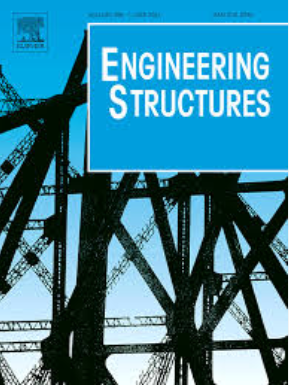Fatigue performance of circular hollow section gap K-joints under corrosive environments
IF 5.6
1区 工程技术
Q1 ENGINEERING, CIVIL
引用次数: 0
Abstract
This paper presents an experimental study on the fatigue behaviour of circular hollow section (CHS) gap K-joints subjected to accelerated electrochemical corrosion. A total of four specimens were examined, comprising three corroded joints and one reference joint, all subjected to cyclic axial loading applied to the chord member, which induced corresponding axial loads in the braces. Prior to fatigue testing, a full-immersion accelerated electrochemical corrosion process was conducted. The surface morphologies of the corroded joints were captured using a high-resolution 3D scanner, and the corrosion characteristics were quantitatively analysed. Fatigue behaviour was assessed at three critical stages, i.e., first visible crack detection (fatigue life N2), development of a through-thickness crack (fatigue life N3), and end of the test (fatigue life N4). Test results revealed that the corroded surfaces exhibited a mixed pattern of general and pitting corrosion, with the maximum pit depth reaching 0.32 mm at the chord crown toe. Crack initiation predominantly occurred in areas of severe corrosion near the maximum stress concentration. At lower fatigue stress amplitudes, corrosion significantly reduced fatigue life N4, while at higher amplitudes, the stress amplitude became the dominant factor. The corroded joints exhibited a gradual accumulation of damage, culminating in sudden failure, which provides less warning compared with non-corroded joints. The existing Sr,hs-N curves in guidelines may overestimate the fatigue life of corroded joints when compared with the experimental database collected from this study and literature. Consequently, Sr,hs-N curves for CHS joints in corrosive environments were developed using multiple linear regression analysis, accounting for the interaction between wall thickness and corrosion fatigue life.
腐蚀环境下圆形空心截面缝隙k形接头的疲劳性能
本文对加速电化学腐蚀作用下圆形空心截面(CHS)缝隙k形接头的疲劳行为进行了试验研究。共检查了四个试件,包括三个腐蚀节点和一个参考节点,所有试件都受到施加在弦杆上的循环轴向载荷,这在支撑中引起了相应的轴向载荷。在疲劳试验之前,进行了全浸加速电化学腐蚀试验。使用高分辨率3D扫描仪捕获腐蚀接头的表面形貌,并定量分析腐蚀特征。疲劳行为在三个关键阶段进行评估,即第一次可见裂纹检测(疲劳寿命N2),贯穿厚度裂纹的发展(疲劳寿命N3)和试验结束(疲劳寿命N4)。试验结果表明,腐蚀表面表现为一般腐蚀和点蚀混合模式,弦冠趾处最大蚀深达到0.32 mm。裂纹萌生主要发生在靠近最大应力集中的严重腐蚀区域。在较低的疲劳应力幅值下,腐蚀显著降低了疲劳寿命N4,而在较高的疲劳应力幅值下,腐蚀成为主导因素。与未腐蚀的接头相比,腐蚀接头的损伤逐渐累积,最终导致突然失效,其警示性较差。指南中现有的Sr、hs-N曲线与本研究收集的实验数据和文献相比,可能高估了腐蚀接头的疲劳寿命。基于此,利用多元线性回归分析,建立了考虑壁厚与腐蚀疲劳寿命交互作用的腐蚀环境下CHS接头的Sr、hs-N曲线。
本文章由计算机程序翻译,如有差异,请以英文原文为准。
求助全文
约1分钟内获得全文
求助全文
来源期刊

Engineering Structures
工程技术-工程:土木
CiteScore
10.20
自引率
14.50%
发文量
1385
审稿时长
67 days
期刊介绍:
Engineering Structures provides a forum for a broad blend of scientific and technical papers to reflect the evolving needs of the structural engineering and structural mechanics communities. Particularly welcome are contributions dealing with applications of structural engineering and mechanics principles in all areas of technology. The journal aspires to a broad and integrated coverage of the effects of dynamic loadings and of the modelling techniques whereby the structural response to these loadings may be computed.
The scope of Engineering Structures encompasses, but is not restricted to, the following areas: infrastructure engineering; earthquake engineering; structure-fluid-soil interaction; wind engineering; fire engineering; blast engineering; structural reliability/stability; life assessment/integrity; structural health monitoring; multi-hazard engineering; structural dynamics; optimization; expert systems; experimental modelling; performance-based design; multiscale analysis; value engineering.
Topics of interest include: tall buildings; innovative structures; environmentally responsive structures; bridges; stadiums; commercial and public buildings; transmission towers; television and telecommunication masts; foldable structures; cooling towers; plates and shells; suspension structures; protective structures; smart structures; nuclear reactors; dams; pressure vessels; pipelines; tunnels.
Engineering Structures also publishes review articles, short communications and discussions, book reviews, and a diary on international events related to any aspect of structural engineering.
 求助内容:
求助内容: 应助结果提醒方式:
应助结果提醒方式:


